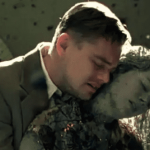 History
History  History
History  Weird Stuff
Weird Stuff 10 Everyday Products Surprisingly Made by Inmates
 Movies and TV
Movies and TV 10 Actors Dragged out of Retirement for One Key Role
 Creepy
Creepy 10 Lesser-Known Shapeshifter Legends from Around the World
 Animals
Animals 10 Amazing Animal Tales from the Ancient World
 Gaming
Gaming 10 Game Characters Everyone Hated Playing
 Books
Books 10 Famous Writers Who Were Hypocritical
 Humans
Humans 10 of the World’s Toughest Puzzles Solved in Record Time
 Mysteries
Mysteries 10 Scientific Mysteries We Don’t Fully Understand
 Weird Stuff
Weird Stuff 10 Celebrities Who Have Admitted to Alien Encounters
 History
History Ten Revealing Facts about Daily Domestic Life in the Old West
 Weird Stuff
Weird Stuff 10 Everyday Products Surprisingly Made by Inmates
 Movies and TV
Movies and TV 10 Actors Dragged out of Retirement for One Key Role
Who's Behind Listverse?

Jamie Frater
Head Editor
Jamie founded Listverse due to an insatiable desire to share fascinating, obscure, and bizarre facts. He has been a guest speaker on numerous national radio and television stations and is a five time published author.
More About Us Creepy
Creepy 10 Lesser-Known Shapeshifter Legends from Around the World
 Animals
Animals 10 Amazing Animal Tales from the Ancient World
 Gaming
Gaming 10 Game Characters Everyone Hated Playing
 Books
Books 10 Famous Writers Who Were Hypocritical
 Humans
Humans 10 of the World’s Toughest Puzzles Solved in Record Time
 Mysteries
Mysteries 10 Scientific Mysteries We Don’t Fully Understand
 Weird Stuff
Weird Stuff 10 Celebrities Who Have Admitted to Alien Encounters
10 Famous Movies That Left Out Terrible Real-Life Endings
The truth is stranger than fiction, or so the adage goes. Hollywood knows this. It feeds off it like a baby seal latched to its momma. But often, the entire truth can be an inconvenient crutch, not for the person living this reality, but for the filmmakers hoping to slap a rose-colored sticker on the forehead of a story with an otherwise ugly ending, which has an inspirational message.
In the process of sanitizing the truth for our entertainment, it is often necessary to cut certain uncomfortable events from the script, re-write important history, or simply ignore it altogether. Here are ten famous Hollywood films that left out terrible endings. SPOILER ALERT
Related: 10 Most Powerful Movie Scenes Between Real-Life Spouses
10 Remember the Titans–Coach Fired
Who could forget the Titans? A team overcoming the odds and going all the way to state champion is the lifeblood of American cinema. Add a dash of racial tension, and you have an instant bestseller. The story of the team from TC Williams High School coached by Herman Boon is an inspirational one and often called upon as one of the sports greatest ever told, catapulting actors into long-term careers and turning ordinary citizens into American heroes.
One such hero was none other than coach Herman Boone, who was at the forefront of the team’s transformation to one of the best. Boone is often celebrated as a hero, and rightfully so, but what the film does not tell us is that Boone was unceremoniously booted from his post as head coach shortly after leading the team to victory. In 1979, Boone was fired after allegations of physical and verbal abuse arose.[1]
9 Schindler’s List–Bankruptcy
Do we need a bad ending to an already horrendous affair of Nazi war crimes and dreadful deaths? No, we do not. Hollywood knew this when they washed the ending of this 1993 film directed by Steven Spielberg.
Oscar Schindler, one of many heroes in WW2, was a German business tycoon who purchased Jewish-owned businesses in Poland in accordance with the German policy of “Germanizing” the community. Schindler employed thousands of Jewish people to work in his factories, thereby saving them from the harsh conditions of the nearby labor camps they would otherwise be subjected to.
What Hollywood never told us, however, is that after the war, Oscar’s life wasn’t all sunshine and roses. He separated from his wife, which was followed by divorce years later. He also ultimately went bankrupt as his business endeavors took a tumble. He took off for West Germany and started a cement company, but in the end, he relied heavily on donations to make ends meet until the date of his death.[2]
8 Unbroken–PTSD
The 2014 Angelina Jolie directed film, Unbroken, brought the story of Louis Zamperini, a long-distance Olympic runner turned prisoner of war, to cinemagoers. After Zamperini, a lieutenant in WW2, had his plane shot down over the Pacific Ocean, Zamperini and fellow survivors resorted to eating birds caught at sea before being picked up and sent to a Japanese POW camp where he was subject to numerous counts of physical and psychological torture at the whims of his captors. The film does not shy away from these harrowing details and the depiction of hardship was relatively on par with the truth.
What the film fails to convey, however, is the effects torture and violence could have on the psyche. When Zamperini returned home having survived the war, he struggled with crippling PTSD and ultimately turned to full-blown alcoholism as a coping mechanism. It was at the hands of religious redemption that Zamperini found renewed purpose and an opportunity to turn his life around for the better.[3]
7 Sound of Music–Nazi House
The Von Trapp family and their do-re-me story of love and family has gripped audiences for decades. When Maria Augusta Kutchera was sent to tutor one of the children of Baron Georg von Trapp, a decorated submarine commander of the First World War, she fell in love with the man and his family, later taking his hand in marriage. The film focuses on her relationship with the children, strained at first until they find each other in the sounds of music.
After the Nazis annexed Austria, the family fled and ultimately ended up in America, where they continued to perform their hits (unfortunately, there was fleeing with luggage over the mountains). What the film fails to address, however, is that the famed Villa Trapp, where the family resided, housed none other than one of the worst human beings in history and Hitler’s closest confidant, Heinrich Himmler. It is rumored that exorcisms had been performed to rid the house of the ghost of Himmler, creaking the floorboards with his boots.[4]
6 A Beautiful Mind–Divorce and Death
A Beautiful Mind, a 2002 film directed by Ron Howard, is an intriguing real-life story of John Nash, who suffered from the devastating effects of schizophrenia. Nash was a math whizz who made astonishing discoveries throughout his career, but the universe had other plans for him. Diagnosed with paranoid schizophrenia, Nash began to experience a series of breaks from reality and crippling paranoia.
Although the film does well to convey the effects the disorder had on Nash, it fails to address his divorce from his wife, Alicia (who remarried later), and that she gave birth to a son who also excelled at math and developed schizophrenia. Their unceremonious end would come in the form of a car accident that killed both Alicia and John. Not the tone you would like to end a Tuesday at the cinema with.[5]
5 Once Upon a Time in Hollywood–Mass Murder
Quenton Tarantino knows spinning history to suit his narrative makes for better storytelling, and Once Upon a Time in Hollywood is no exception to his rule. The film follows a fictional actor, Rick Dalton (Leonardo DiCaprio), and his stunt double, Cliff Booth (Brad Pit), as they attempt to remain relevant in the Hollywood big leagues. Throughout the film, the foreboding of what is to come becomes apparent. Actress Sharon Tate goes about her business while Charles Watson leads a crew of religious fanatics under the leadership of Charles Manson to extreme outcomes.
By the time the movie is over, Watson has been shredded by a pitbull and his acolytes killed in true Tarantino grotesqueness, with Tate safe and sound in her home. But in reality, the end of Tate was quite different. In fact, on the night of August 9, 1969, Tate (who was eight months pregnant at the time) was murdered by four members of the Manson family cult. The ritualistic manner of the killings gave rise to the Satanic Panic, and the swinging sixties came crashing down.[6]
4 Aviator–Mental Collapse
Martin Scorcese’s Oscar-winning portrayal of the life of the eccentric rich man, Howard Hughes, did a decent job of showcasing Howard’s life. From playboy millionaire to film producer and director, even highlighting his antics as a capable and skilled pilot. The film also highlights Howard’s long-term fight with germophobia and OCD (not the OCD your friends cry about when they can’t direct their attention away from their phones). But in the end, it falls short in listing the various degrees of mental illness Howard suffered from.
Although Hughes had many women throughout his life, his final marriage lasted 14 years and was characterized by strange behaviors, such as sleeping in separate rooms and communicating via handwritten letters. By the end of Hughe’s life, his OCD had regressed to such an extent that he basically became paralyzed with fear at anything that might contain germs, wearing shoe boxes for shoes and remaining permanently naked in his room as a means to avoid contamination.[7]
3 Finding Neverland–Tragic Death
Finding Neverland is a 2004 film starring Johnny Depp and Kate Winslet, based on the story of J.M. Barrie and the inspiration for the now infamous Peter Pan. Barrie, an aspiring playwright, takes his dog to the park one afternoon, where he meets the children of Llwellyn Davies, four boys named George, Jack, Michael, and, you guessed it, Peter. The boys introduce him to their recently widowed mother, Sylvia, and the two become best friends. There are rumors and whispers across the town about the relationship and whatnot, but in the end, Barrie becomes a part of their little family.
At the end of the movie, Sylvia passes away, leaving Barrie to care for the children. Barrie, in turn, makes a promise to little Peter that he would take care of him, and the movie ends with the two seeking comfort in each other’s arms.
What happened next was not in the movie and is as infamous as it is tragic. Peter Pan became a historical figure in the literary world, but George died as a soldier when he was 21, Michael drowned at 20 in an apparent suicide, John passed from a lung disease at 65, and Peter, the title character, died from suicide at age 63. Barrie himself died of pneumonia at 77. And scene—bow out.[8]
2 Erin Brockovich–Ghost Town
Erin Brockovich gave Julia Roberts her Oscar. A film about a water activist shows how Brokovich tenaciously fought off big corporations, ultimately holding them accountable for contaminating the water supply of Hinkley, California.
At the end of the film, the judge orders PG&E, the company responsible for the contamination, to pay a settlement amount of millions of dollars to be distributed amongst the plaintiffs. At $333 million, it was the largest suit paid to date.
The damage was done, however, as over time, the Hinkley residents had packed their bags and took off for cleaner pastures. The town has regressed to the point that it could almost be considered a ghost town, with efforts to clean the water taking longer than anticipated.[9]
1 Titanic–Charge for Attire
When James Cameron brought the story of the tragic sinking of the RMS Titanic to light, Rose and Leo had viewers reaching for the tissues. How does the sinking of the ship killing thousands and the death of the main protagonist in the most dramatic way leave out a tragic ending, you ask? Easy.
In the aftermath of the tragedy, there were many bones to pick, wills and testaments that needed settling, and lawsuits against the White Star Line. One of the standout tragic endings was the plight of the musicians, led by Wallace Hartley, who chose to ply their trade until their feet were wet with the chill of the Atlantic ice water. All eight musicians perished.
Shortly after the sinking, the father of John Hume, a cellist onboard the ship, received a note from an agency requesting the payment of 14 shillings and 7 pence owed to them for the attire rented and not returned. They refused to pay. A true ending that deserves to be drowned along with history.[10]








